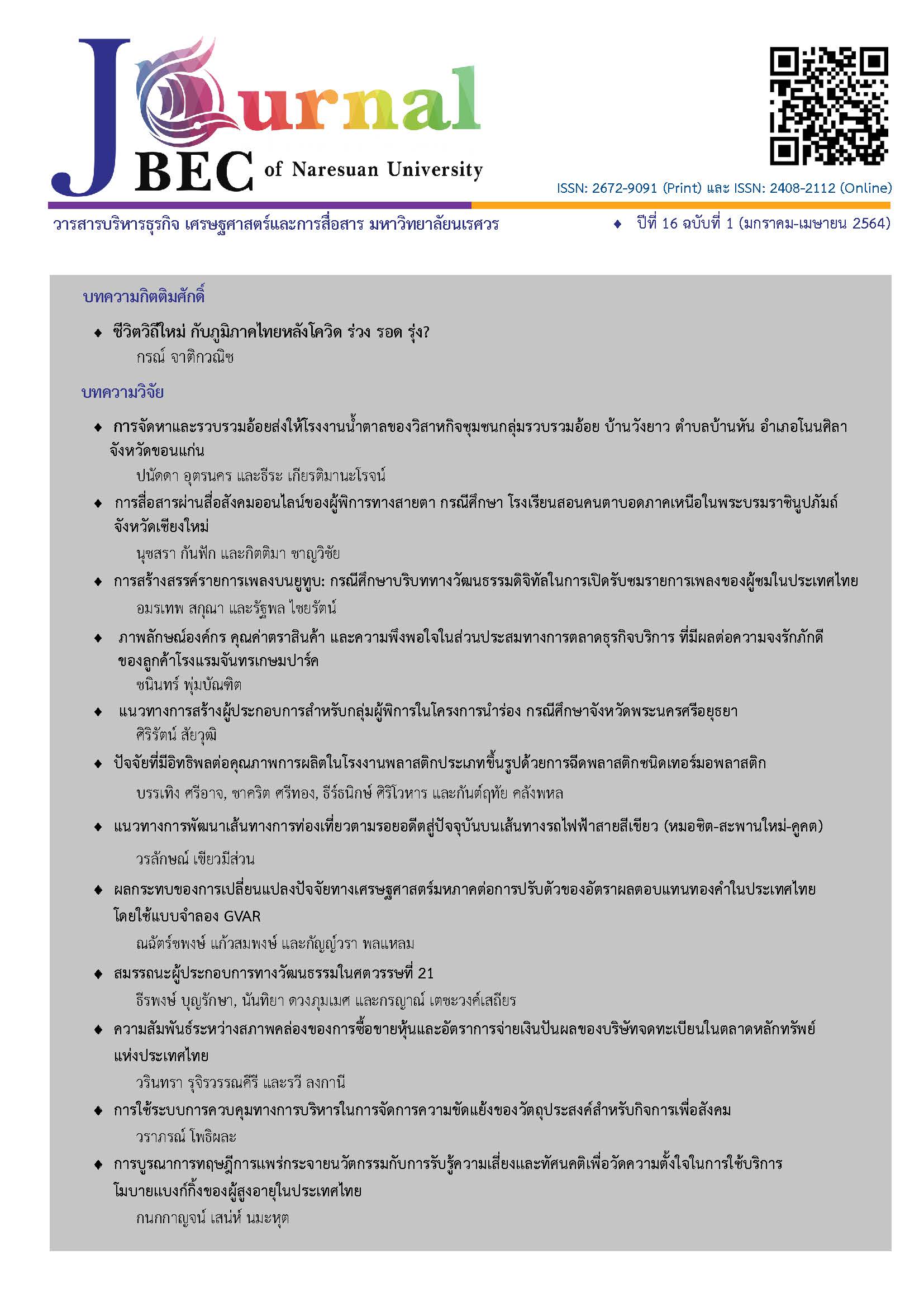ความสัมพันธ์ระหว่างสภาพคล่องของการซื้อขายหุ้นและอัตราการจ่ายเงินปันผล ของบริษัทจดทะเบียนในตลาดหลักทรัพย์แห่งประเทศไทย
Main Article Content
บทคัดย่อ
ในทางทฤษฎีนั้น สภาพคล่องของการซื้อขายหุ้นที่เพิ่มขึ้นสามารถทำให้การจ่ายเงินปันผลเพิ่มขึ้นเพราะปัญหาความอสมมาตรของข้อมูลลดลง หรืออาจสัมพันธ์ในทางลบถ้าหากการจ่ายเงินปันผลและสภาพคล่องเป็นการดำเนินงานที่ทดแทนกันได้ การศึกษานี้มีวัตถุประสงค์ 1)เพื่อทดสอบความสัมพันธ์ระหว่างสภาพคล่องของการซื้อขายหุ้นที่มีต่ออัตราการจ่ายเงินปันผล ใช้ตัวอย่างข้อมูลประกอบในการศึกษาจากบริษัทจดทะเบียนในตลาดหลักทรัพย์แห่งประเทศไทยทั้งหมด 2,834 ตัวอย่าง ในช่วงระหว่าง พ.ศ.2551-2559 ผลการศึกษาพบความสัมพันธ์เชิงลบระหว่างสภาพคล่องของการซื้อขายและอัตราการจ่ายเงินปันผล การศึกษานี้ได้ทดสอบต่อไปโดยใช้ตัวแปรการจ่ายปันผลที่แตกต่างกัน 2)เพิ่มเงื่อนไขของความโปร่งใสของข้อมูลเพิ่มขึ้น ซึ่งพบความสัมพันธ์เชิงบวกระหว่างสภาพคล่องของการซื้อขายและอัตราการจ่ายเงินปันผล เมื่อข้อมูลมีความโปร่งใสมากขึ้น 3) เพิ่มเงื่อนไขของปัญหาตัวแทนที่แตกต่างกัน พบว่าไม่พบความสัมพันธ์ระหว่างสภาพคล่องของการซื้อขายและอัตราการจ่ายเงินปันผล
Article Details
เอกสารอ้างอิง
Amihud, Y. (2002). Illiquidity and stock returns: cross-section and time-series effects. Journal of Financial Market, 5 (1), 31–56.
Amihud, Y., Mendleson, H. (1986). Asset pricing and the bid-ask spread. Journal of Financial Economics, 17, 223-249.
Atcharawan, P. (2002). Dividend, Asymmetric Information, and Agency Conflicts: A Comparative Study of the Dividend Policies of Thai and U.S. Firms. Master thesis, M.S. in Finance, Chulalongkorn University, Bangkok.
Banerjee, S., Gatchev, V.A., Spindt, P.A. (2007). Stock market liquidity and firm dividend policy. Journal of Financial and Quantitative Analysis, 42 (2), 369–397.
Becker, C.L., DeFond, M.L., Jiambalvo, J., Subramanyam, K.R. (1998). The effect of audit quality on earnings management. Contemporary Accounting Research, 15 (1), 1-24.
Behide, A. (1993). The hidden costs of stock market liquidity. Journal of Finance Economics, 34 (1), 31-51.
Brennan, M.J., Thakor, A.V. (1990). Shareholder preference and dividend policy. Journal of Finance, 45(4), 993-1108.
Chai, D., Faff, R. and Gharghori, P. (2010). New evidence on the relation between stock liquidity and measures of trading activity. International Review of Financial Analysis, 19 (3), 181-192.
Coffee, J. (1991). Liquidity versus control: the institution investor as corporate monitor. Columbia Law Review, 91 (6), 1277-1368.
Easterbrook, F.H. (1984). Two agency-cost explanations of dividends. The American Economic Review, 74(4). 650-659.
Edmans, A., Fang, V., Zur, E. (2013). The effect of liquidity on governance. Finance Review, 26 (6), 1443–1482.
Fama, E.F., MacBeth, J.D. (1973). Business conditions and expected returns on stocks and bonds. Journal of Financial Economics, 25, 23–49.
Francis, B., Hasan, I., John, K. and Song, L. (2011). Corporate governance and dividend payout policy: a test using antitakeover legislation. Financial Management. 40 (1), 83-112.
Holmstrom, B., Tirole, J. (1993). Market liquidity and performance monitoring. The Journal of Political Economy, 101 (4), 678–709.
Jiang, F., Ma, Y., Shi, B. (2017). Stock liquidity and dividend payouts. Journal of Corporate Finance, 42, 295–314.
Jensen, M.C. (1986). Agency cost of free cash flow, corporate finances and takeover. The American Economic Review, 76 (2), 323-329.
Jones, J. (1991). Earnings management during import relief investigations. Journal of Accounting Research, 29 (2), 151-6.
Jumreornvong, S. (2011). Corporate Financial Management: Concepts and Applications (2nd ed.). Pathum Thani: Thummasat University Press.
Kyle, A.s., Vila, J.L. (1991). Noise trading and takeovers. The RAND Journal of Economics, 22, 54-71.
La Porta, R., Lopez-de Silanes, F., Sheifer, A. and Vishny, R., (2000). Agency problems and policies around the world. Journal of Finance, 55 (1), 1-33.
Miller, M.H., Modigliani, F. (1961). Dividend policy, growth, and the valuation of shares. Journal of Business, 34(4), 411–433.
Minton, T. (2004). Corporate governance and dividend policy in emerging markets. Emerging Markets Review, 5(4), 409-426.
Pastor, L. and Stambaugh, R.F. (2003). Liquidity risk and expected stock returns. Journal of Political Economy, 111, 642-685.
Sukhahuta, D. (2018). Effect of Corporate Governance on Relationship between CEO Power and Cost of Debt. BU Academic review, 17(2), 104-120.
The Security Exchange of Thailand. (2013). Dividend Payment. Retrieved April 10, 2017, from https://www.set.or.th/th/regulations/simplified_regulations/dividend_p1.html


